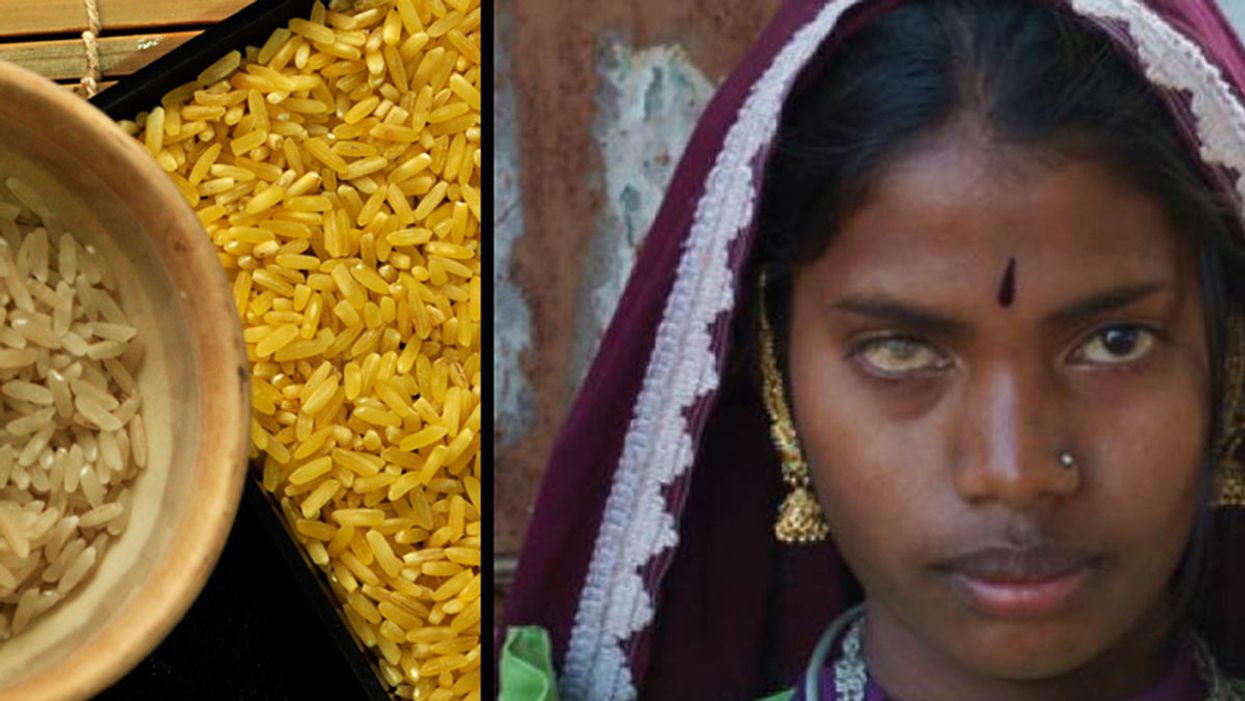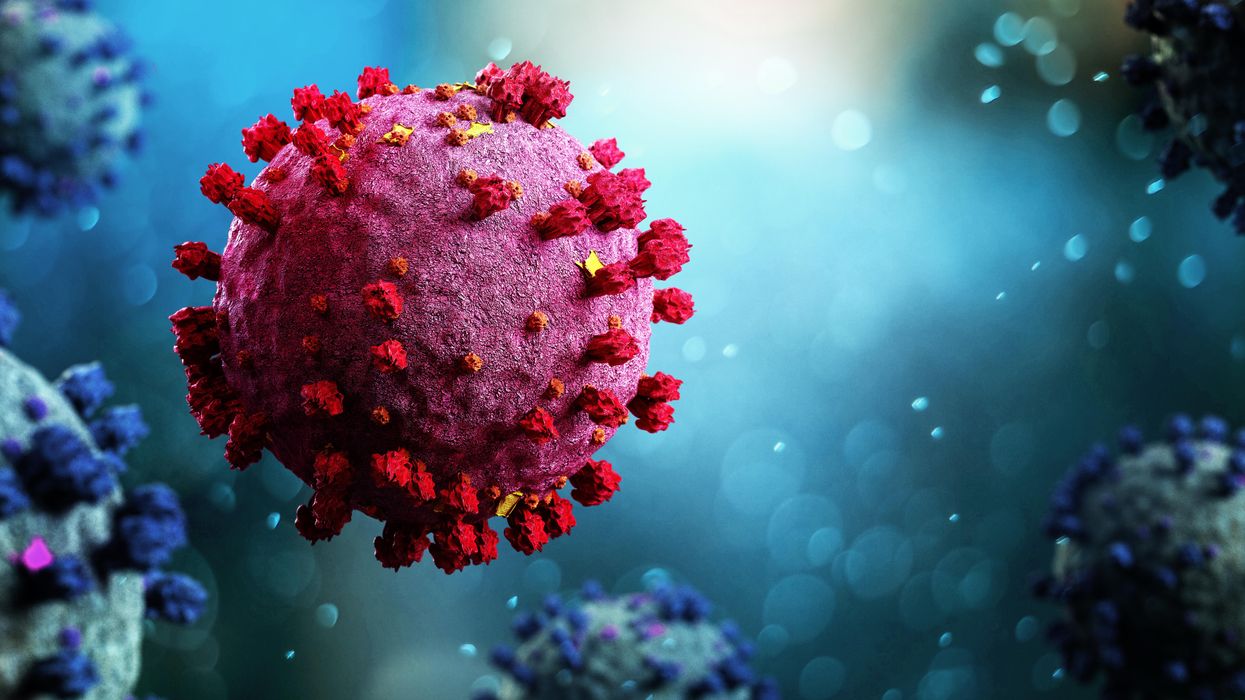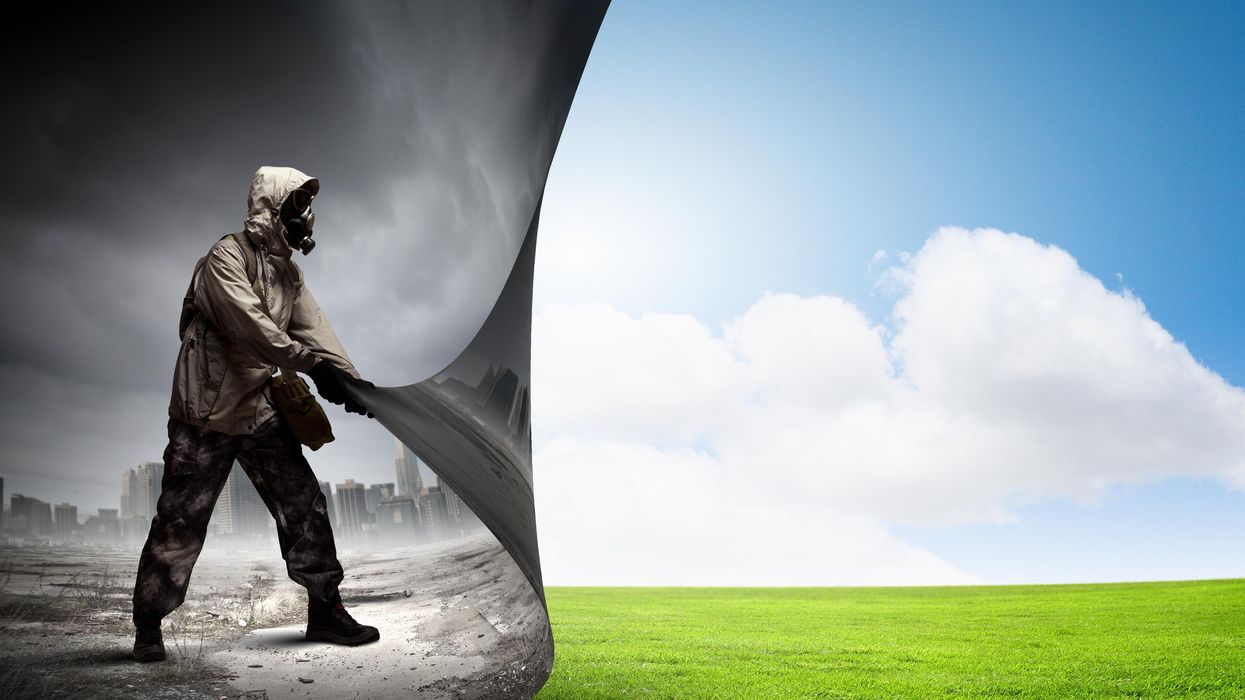We Pioneered a Technology to Save Millions of Poor Children, But a Worldwide Smear Campaign Has Blocked It

On left, a picture of white rice next to Golden Rice, and on right, a girl who lost one eye due to vitamin A deficiency.
In a few weeks it will be 20 years that we three have been working together. Our project has been independently praised as one of the most influential of all projects of the last 50 years.
Two of us figured out how to make rice produce a source of vitamin A, and the rice becomes a golden color instead of white.
The project's objectives have been admired by some and vilified by others. It has directly involved teams of highly motivated people from a handful of nations, from both the private and public sector. A book, dedicated to the three of us, has been written about our work. Nevertheless, success has, so far, eluded us all. The story of our thwarted efforts is a tragedy that we hope will soon – finally – reach a milestone of potentially profound significance for humanity.
So, what have we been working on, and why haven't we succeeded yet?
Food: everybody needs it, and many are fortunate enough to have enough, even too much of it. Food is a highly emotional subject on every continent and in every culture. For a healthy life our food has to provide energy, as well as, in very small amounts, minerals and vitamins. A varied diet, easily achieved and common in industrialised countries, provides everything.
But poor people in countries where rice is grown often eat little else. White rice only provides energy: no minerals or vitamins. And the lack of one of the vitamins, vitamin A, is responsible for killing around 4,500 poor children every day. Lack of vitamin A is the biggest killer of children, and also the main cause of irreversible childhood blindness.
Our project is about fixing this one dietary deficiency – vitamin A – in this one crop – rice – for this one group of people. It is a huge group though: half of the world's population live by eating a lot of rice every day. Two of us (PB & IP) figured out how to make rice produce a source of vitamin A, and the rice becomes a golden color instead of white. The source is beta-carotene, which the human body converts to vitamin A. Beta-carotene is what makes carrots orange. Our rice is called "Golden Rice."
The technology has been donated to assist those rice eaters who suffer from vitamin A deficiency ('VAD') so that Golden Rice will cost no more than white rice, there will be no restrictions on the small farmers who grow it, and nothing extra to pay for the additional nutrition. Very small amounts of beta-carotene will contribute to alleviation of VAD, and even the earliest version of Golden Rice – which had smaller amounts than today's Golden Rice - would have helped. So far, though, no small farmer has been allowed to grow it. What happened?
To create Golden Rice, it was necessary to precisely add two genes to the 30,000 genes normally present in rice plants. One of the genes is from maize, also known as corn, and the other from a commonly eaten soil bacterium. The only difference from white rice is that Golden Rice contains beta-carotene.
It has been proven to be safe to man and the environment, and consumption of only small quantities of Golden Rice will combat VAD, with no chance of overdosing. All current Golden Rice results from one introduction of these two genes in 2004. But the use of that method – once, 15 years ago - means that Golden Rice is a 'GMO' ('genetically modified organism'). The enzymes used in the manufacture of bread, cheese, beer and wine, and the insulin which diabetics take to keep them alive, are all made from GMOs too.
The first GMO crops were created by agri-business companies. Suspicion of the technology and suspicion of commercial motivations merged, only for crop (but not enzymes or pharmaceutical) applications of GMO technology. Activists motivated by these suspicions were successful in getting the 'precautionary principle' incorporated in an international treaty which has been ratified by 166 countries and the European Union – The Cartagena Protocol.
The equivalent of 13 jumbo jets full of children crashes into the ground every day and kills them all, because of vitamin A deficiency.
This protocol is the basis of national rules governing the introduction of GMO crops in every signatory country. Government regulators in, and for, each country must agree before a GMO crop can be 'registered' to be allowed to be used by the public in that country. Currently regulatory decisions to allow Golden Rice release are being considered in Bangladesh and the Philippines.
The Cartagena Protocol obliges the regulators in each country to consider all possible risks, and to take no account of any possible benefits. Because the anti-gmo-activists' initial concerns were principally about the environment, the responsibility for governments' regulation for GMO crops – even for Golden Rice, a public health project delivered through agriculture – usually rests with the Ministry of the Environment, not the Ministry of Health or the Ministry of Agriculture.
Activists discovered, before Golden Rice was created, that inducing fear of GMO food crops from 'multinational agribusinesses' was very good for generating donations from a public that was largely illiterate about food technology and production. And this source of emotionally charged donations would cease if Golden Rice was proven to save sight and lives, because Golden Rice represented the opposite of all the tropes used in anti-GMO campaigns.
Golden Rice is created to deliver a consumer benefit, it is not for profit – to multinational agribusiness or anyone else; the technology originated in the public sector and is being delivered through the public sector. It is entirely altruistic in its motivations; which activists find impossible to accept. So, the activists believed, suspicion against Golden Rice had to be amplified, Golden Rice had to be stopped: "If we lose the Golden Rice battle, we lose the GMO war."
Activism continues to this day. And any Environment Ministry, with no responsibility for public health or agriculture, and of course an interest in avoiding controversy about its regulatory decisions, is vulnerable to such activism.
The anti-GMO crop campaigns, and especially anti-Golden Rice campaigns, have been extraordinarily effective. If so much regulation by governments is required, surely there must be something to be suspicious about: 'There is no smoke without fire'. The suspicion pervades research institutions and universities, the publishers of scientific journals and The World Health Organisation, and UNICEF: even the most scientifically literate are fearful of entanglement in activist-stoked public controversy.
The equivalent of 13 jumbo jets full of children crashes into the ground every day and kills them all, because of VAD. Yet the solution of Golden Rice, developed by national scientists in the counties where VAD is endemic, is ignored because of fear of controversy, and because poor children's deaths can be ignored without controversy.
Perhaps more controversy lies in not taking scientifically based regulatory decisions than in taking them.
The tide is turning, however. 151 Nobel Laureates, a very significant proportion of all Nobel Laureates, have called on the UN, governments of the world, and Greenpeace to cease their unfounded vilification of GMO crops in general and Golden Rice in particular. A recent Golden Rice article commented, "What shocks me is that some activists continue to misrepresent the truth about the rice. The cynic in me expects profit-driven multinationals to behave unethically, but I want to think that those voluntarily campaigning on issues they care about have higher standards."
The recently published book has exposed the frustrating saga in simple detail. And the publicity from all the above is perhaps starting to change the balance of where controversy lies. Perhaps more controversy lies in not taking scientifically based regulatory decisions than in taking them.
But until they are taken, while there continues a chance of frustrating the objectives of the Golden Rice project, the antagonism will continue. And despite a solution so close at hand, VAD-induced death and blindness, and the misery of affected families, will continue also.
© The Authors 2019. This article is distributed under the terms of the Creative Commons Attribution 4.0 International License, which permits unrestricted use, distribution, and reproduction in any medium, provided you give appropriate credit to the original author(s) and the source, provide a link to the Creative Commons license, and indicate if changes were made. The Creative Commons Public Domain Dedication waiver applies to the data made available in this article, unless otherwise stated.
You won't score many glamor points for using a neti pot, but it could be a worthwhile asset in fighting Covid-19, according to the author's experience and recent research.
Twice a day, morning and night, I use a neti pot to send a warm saltwater solution coursing through one nostril and out the other to flush out debris and pathogens. I started many years ago because of sinus congestion and infections and it has greatly reduced those problems. Along with vaccination when it became available, it seems to have helped with protecting me from developing Covid-19 symptoms despite being of an age and weight that puts me squarely at risk.
Now that supposition of protection has been backed up with evidence from a solidly designed randomized clinical trial. It found that irrigating your sinuses twice a day with a simple saltwater solution can lead to an 8.5-fold reduction in hospitalization from Covid-19. The study is another example of recent research that points to easy and inexpensive ways to help protect yourself and help control the epidemic.
Amy Baxter, the physician researcher behind the study at Augusta University, Medical College of Georgia, began the study in 2020, before a vaccine or monoclonal antibodies became available to counter the virus. She wanted to be able to offer another line of defense for people with limited access to healthcare.
The nasal cavity is the front door that the SARS-CoV-2 virus typically uses to enter the body, latching on to the ACE2 receptors on cells lining those tissue compartments to establish infection. Once the virus replicates here, infection spreads into the lungs and often other parts of the body, including the brain and gut. Some studies have shown that a mouthwash could reduce the viral load, but any effect on disease progression was less clear. Baxter reasoned that reducing the amount of virus in the nose might give the immune system a better chance to react and control that growth before it got out of hand.
She decided to test this approach in patients who had just tested positive for Covid-19, were over 55 years of age, and often had other risk factors for developing serious symptoms. It was the quickest and easiest way to get results. A traditional prevention study would have required many more volunteers, taken a longer period of follow up, and cost money she did not have.
The trial enrolled 79 participants within 24 hours of testing positive for Covid-19, and they agreed to follow the regimen of twice daily nasal irrigation. They were followed for 28 days. One patient was hospitalized; a 1.27% rate compared with 11% in a national sample control group of similar age people who tested positive for Covid-19. Patients who strictly adhered to nasal irrigation had fewer, shorter and less severe symptoms than people in the study who missed some of their saline rinses.
Baxter initially made the results of her clinical trial available as a preprint in the summer of 2021 and was dismayed when many of the comments were from anti-vaxxers who argued this was a reason why you did not need to get vaccinated. That was not her intent.
There are several mechanisms that explain why warm saltwater is so effective. First and most obvious is the physical force of the water that sweeps away debris just as a rainstorm sends trash into a street gutter and down a storm drain. It also lubricates the cilia, small hair-like structures whose job it is to move detritus away from cells for expulsion. Cilia are rich in ACE2 receptors and keeping them moving makes it harder for the virus to latch on to the receptors.
It turns out the saline has a direct effect on the virus itself. SARS-CoV-2 becomes activated when an enzyme called furin snips off part of its molecular structure, which allows the virus to grab on to the ACE2 receptor, but saline inhibits this process. Once inside a cell the virus replicates best in a low salt environment, but nasal cells absorb salt from the irrigation, which further slows viral replication, says Baxter.
Finally, “salt improves the jellification of liquid, it makes better and stickier mucus so that you can get those virus out,” she explains, lamenting, “Nobody cares about snot. I do now.”
She initially made the results of her clinical trial available as a preprint in the summer of 2021 and was dismayed when many of the comments were from anti-vaxxers who argued this was a reason why you did not need to get vaccinated. That was not her intent. Two journals rejected the paper, and Baxter believes getting caught up in the polarizing politics of Covid-19 was an important part of the reason why. She says that editors “didn't want to be associated with something that was being used by anti-vaxxers.” She strongly supports vaccination but realizes that additional and alternative approaches also are needed.
Premeasured packets of saline are inexpensive and can be purchased at any drug store. They are safe to use several times a day. Say you’re vaccinated but were in a situation where you fear you might have been exposed to SARS-CoV-2; an extra irrigation will clear out your sinuses and may reduce the risk of that possible exposure.
Baxter plans no further study in this area. She is returning to her primary research focus, which is pain control and reducing opioid use, but she hopes that others will expand on what she had done.
Podcast: The Friday Five Weekly Roundup in Health Research
In this week's Friday Five: progress on a pill to prevent lung cancer. Plus, ancient wisdom about Neti pots could pay off against Covid, a breakthrough for precision medicine and obesity, the connection between taking a multivitamin pill and brain health - and much more.
The Friday Five covers five stories in research that you may have missed this week. There are plenty of controversies and troubling ethical issues in science – and we get into many of them in our online magazine – but this news roundup focuses on scientific creativity and progress to give you a therapeutic dose of inspiration headed into the weekend.
Listen on Apple | Listen on Spotify | Listen on Stitcher | Listen on Amazon | Listen on Google
Here are the promising studies covered in this week's Friday Five:
- A pill to prevent lung cancer?
- Ancient wisdom about Neti pots could pay off for Covid
- Breakthrough for precision medicine and obesity
- How to refreeze the north and south poles
- The connection between taking multivitamin pills and brain health

